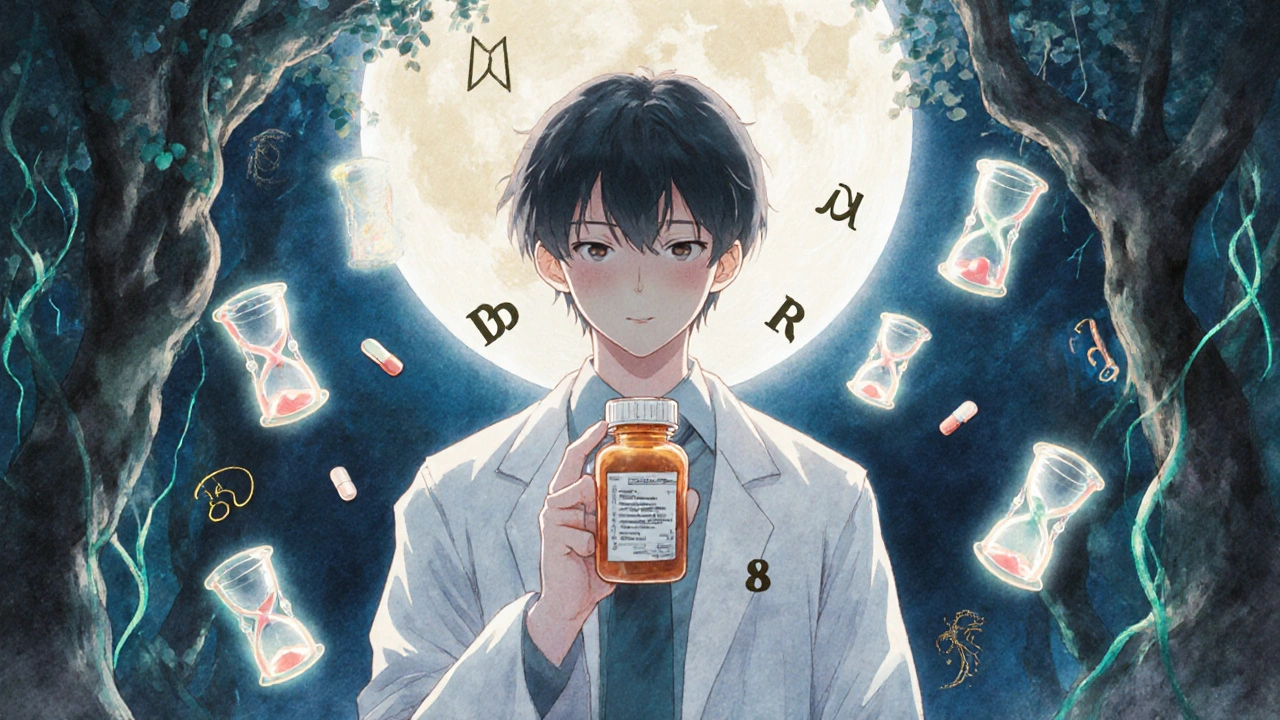Ever stared at your prescription label and felt like you’re reading a secret code? BID, TID, PRN-these aren’t random letters. They’re Latin shortcuts that doctors and pharmacists have used for over a century. And if you don’t know what they mean, you could be taking your medicine wrong. It’s not just confusing-it’s dangerous.
Here’s the truth: 68% of patients in the U.S. say they don’t fully understand what’s written on their prescription labels. That’s not because you’re not smart. It’s because the system hasn’t kept up. Even in 2025, you’ll still see these old abbreviations on pills, inhalers, and liquid meds. But you don’t have to guess. Let’s break them down, plain and simple.
What BID, TID, and PRN Really Mean
BID stands for bis in die-Latin for "twice a day." It doesn’t mean "breakfast and dinner." It means two doses, spaced about 12 hours apart. So if your doctor writes BID, take one pill at 8 a.m. and another at 8 p.m. That keeps the medicine steady in your bloodstream. If you take both doses at breakfast and dinner, you’re leaving a 16-hour gap. That’s not enough for some drugs-especially antibiotics. A 2021 Johns Hopkins study found that when antibiotics were taken with uneven spacing, treatment effectiveness dropped by 27%.
TID means ter in die-"three times a day." Again, it’s not "breakfast, lunch, dinner." It’s three doses, roughly every 8 hours. That’s 6 a.m., 2 p.m., and 10 p.m. Why 8 hours? Because many drugs need consistent levels in your blood to work. A Mayo Clinic study in 2020 showed that if doses were spaced more than 2 hours off from 8-hour intervals, drug efficacy fell by 38%. That’s the difference between healing and lingering infection.
PRN is short for pro re nata, which means "as needed." This one trips up the most people. PRN doesn’t mean "take it whenever you feel like it." It always comes with limits. For example: "Ibuprofen 400mg PRN for pain, max 3 doses in 24 hours." That means you can take it only when you have pain, and only up to three times total in a day. No more. If you take it every 2 hours because your knee hurts, you’re risking stomach bleeding or liver damage. The FDA says PRN medications cause 31% of all dosing errors-mostly because patients think "as needed" means "whenever."
The Other Abbreviations You’ll See
There are more than 40 standard pharmacy abbreviations. You don’t need to memorize them all, but here are the most common ones you’ll find on your labels:
- QD or q.d. = once daily. Take it at the same time every day, like when you brush your teeth.
- QID or q.i.d. = four times daily. That’s every 6 hours: 6 a.m., 12 p.m., 6 p.m., 12 a.m.
- Q4H or q.4h. = every 4 hours. This is common for pain meds after surgery.
- AC = before meals. Take it 30 to 60 minutes before eating.
- PC = after meals. Take it within 30 minutes after you finish eating.
- HS = at bedtime. Usually means right before you go to sleep.
- PO = by mouth. This tells you it’s an oral pill or liquid-not a shot, cream, or inhaler.
Some labels skip the periods. You might see "BID" instead of "b.i.d." That’s okay. It’s still the same thing. But watch out for weird versions like "T.I.W." (three times a week)-that’s been banned because people confuse it with "TID."
Why These Abbreviations Still Exist
You’d think we’d have gotten rid of them by now. After all, we have electronic prescriptions, smartphones, and AI assistants. But here’s the reality: 68% of U.S. prescriptions still use Latin abbreviations, according to a 2022 FDA report. Why? Because doctors learned them in medical school. Many still write them out of habit. Even though The Joint Commission banned risky abbreviations like "U" for units (which got mistaken for "0" and caused deadly insulin overdoses), the big ones-BID, TID, PRN-are still everywhere.
There’s also a generational divide. A 2024 New England Journal of Medicine piece found that 38% of active U.S. doctors are over 50. Many were trained using these abbreviations and still use them. Meanwhile, younger doctors are being pushed to use plain English. But change moves slowly.
And it’s not just the U.S. In the U.K., "BD" means twice daily. But if you’re a U.S. traveler and see "BD" on a prescription abroad, you might think it means "bedtime." That’s exactly what happened in a 2022 BMJ case report. The patient took their medication only at night-and it didn’t work.

How to Avoid Mistakes
Here’s how to stay safe:
- Ask your pharmacist. Seriously. They’re paid to explain this stuff. A 2022 Pharmacy Times survey found that 89% of patients felt way more confident after a pharmacist walked them through their label. No shame in asking. Pharmacists expect it.
- Use the "teach-back" method. After the pharmacist explains, say: "So just to make sure I got it-you’re saying I take this twice a day, 12 hours apart, and I can’t take more than three pills in 24 hours?" If you can say it back right, you understand it.
- Use a pill organizer. Buy one with time slots labeled: Morning, Afternoon, Evening, Bedtime. Fill it weekly. A 2021 Annals of Internal Medicine study showed this improved adherence by 52%.
- Download a medication app. Apps like Medisafe (used by over 18 million people) let you scan your prescription label. It automatically converts "TID" to "Take at 6 a.m., 2 p.m., 10 p.m." and sends you phone alerts. No more guessing.
- Do a "brown bag review." Once a month, bring all your meds-bottles, creams, patches-to your doctor or pharmacist. They’ll spot mismatches. One patient found her blood thinner label said "PRN," but the doctor meant weekly blood tests. It took three calls to fix it.
What’s Changing-And When
The good news? The system is finally changing.
The United States Pharmacopeia (USP) just mandated that all Latin abbreviations must be eliminated from prescriptions by December 31, 2025. That’s not a suggestion. That’s a rule. Kaiser Permanente switched to plain English in 2022-and saw a 29% drop in patients calling to ask what their meds meant.
Big pharmacy chains like CVS and Walmart are already ahead. They now include plain-English instructions on 74% and 78% of labels, respectively. But independent pharmacies? Only 41% do it. If you get your meds from a small local pharmacy, don’t assume they’ve updated their system.
By 2027, experts predict less than 5% of prescriptions will use Latin abbreviations. The future is clear instructions: "Take one tablet twice daily, 12 hours apart," not "BID."

What to Do Right Now
You don’t have to wait for the system to fix itself. Here’s your action plan:
- When you pick up a new prescription, read the label out loud. If any word looks like Latin, pause.
- Ask the pharmacist: "Can you tell me exactly when to take this?"
- Write down the times in your phone calendar with alarms.
- If you’re helping someone older, sit with them and explain it using their daily routine-"Take this after your morning coffee," not "take it AC."
- Never assume. If you’re unsure, call the pharmacy. It’s better than taking the wrong dose.
Medication errors kill over 250,000 people in the U.S. every year. A big chunk of those come from simple misunderstandings. You’re not just reading a label-you’re protecting your health. And you don’t need a medical degree to do it right.
What does BID mean on a prescription?
BID means "twice a day." It comes from the Latin phrase "bis in die." Take your medication two times each day, roughly 12 hours apart-for example, 8 a.m. and 8 p.m. This keeps the drug level steady in your body. Don’t assume it means breakfast and dinner unless your pharmacist confirms it.
Is TID the same as three times a day?
Yes, TID means "three times a day" from the Latin "ter in die." But it’s not just three doses anytime. They should be spaced about 8 hours apart-like 6 a.m., 2 p.m., and 10 p.m. Taking them only at meals (breakfast, lunch, dinner) creates uneven spacing, which can reduce how well the medicine works. A Mayo Clinic study found that even small timing errors can drop effectiveness by 38%.
Can I take PRN medicine whenever I want?
No. PRN means "as needed," but it always comes with rules. For example: "Acetaminophen 500mg PRN for headache, max 4 doses in 24 hours." You can only take it when you have a headache, and only up to four times in a day. Taking it more often-even if you feel like it-can cause liver damage. Always check the maximum daily dose on the label.
Why do pharmacies still use Latin abbreviations?
Many doctors learned them in medical school and still use them out of habit. Even though electronic systems make it easy to write plain English, some still type "BID" because it’s faster. The FDA and safety groups have been pushing to phase them out since 2004, but change is slow. By 2025, U.S. law will require all prescriptions to use plain language, but until then, you’ll still see them.
What should I do if I don’t understand my prescription label?
Call your pharmacy. Don’t guess. Pharmacists are trained to explain these labels, and they expect these questions. You can also ask your doctor during your next visit. Write down your questions ahead of time. If you’re helping someone else, sit with them and go over the label together. Misunderstanding your meds is one of the most common causes of hospital visits-and it’s totally avoidable.
Are there apps that help decode prescription labels?
Yes. Apps like Medisafe, MyTherapy, and Dosecast let you scan your prescription label. They automatically convert abbreviations like TID or PRN into plain English and set reminders with specific times. Medisafe alone has over 18 million users. These tools reduce missed doses by up to 40% and are especially helpful for older adults or people taking multiple medications.
Next Steps for Safe Medication Use
If you’re managing your own meds, start today: Open your medicine cabinet. Grab one bottle. Read the label. If you see BID, TID, or PRN-don’t assume. Call your pharmacy. Ask for the exact times. Write them down. Set phone alarms. Do this for every new prescription.
If you’re caring for someone else-especially an older adult-help them use a pill organizer. Fill it together. Check the label every week. If you notice a pattern-like they’re skipping doses or taking too much-talk to their doctor. Don’t wait for a crisis.
The goal isn’t to memorize Latin. It’s to take your medicine right. And that starts with one simple question: "Can you tell me exactly when to take this?"



vanessa k
November 11, 2025 AT 05:56My grandma took her blood pressure med at breakfast and dinner like it was a meal and ended up in the ER. I didn’t know BID meant 12 hours apart until I read this. Thank you for actually explaining it like a human.
manish kumar
November 12, 2025 AT 11:23As someone from India where we still use "BD" and "TID" on handwritten scripts, I can tell you this confusion is global. My uncle once took his antibiotic TID but thought it meant "three times after meals"-so he took it at 8 a.m., 1 p.m., and 8 p.m.-and the infection came back worse. It took three visits to the doctor to realize he was spacing it wrong. The 8-hour rule isn’t just medical jargon-it’s science. And honestly, if your doctor writes "TID" without explaining the timing, they’re doing you a disservice. We need plain language everywhere, not just in fancy hospitals. This article should be mandatory reading for every pharmacy tech, every nurse, every doctor who thinks "everyone knows what PRN means." They don’t. And people die because of it.
Nicole M
November 14, 2025 AT 08:34Wait-so PRN isn’t just "take it when you feel like it"? I’ve been taking ibuprofen every 3 hours because my back hurts. That’s bad, right?
Arpita Shukla
November 15, 2025 AT 13:14Actually, you’re both wrong. PRN means "as needed" but only if the condition is objectively present. If you’re just feeling "a little achy," you shouldn’t take it. And if you’re taking ibuprofen every 3 hours, you’re not just risking your stomach-you’re masking a deeper issue. Also, the 8-hour spacing for TID is only true for certain drugs. For antibiotics like amoxicillin, it’s more flexible. For others, like digoxin, timing is critical. You can’t generalize. The real problem is that this article oversimplifies. Medical dosing is nuanced. And if you’re using an app to tell you when to take your pills, you’re outsourcing your brain. Learn the principles, not just the reminders.
Benjamin Stöffler
November 16, 2025 AT 22:56And yet… we still use Latin. Why? Because medicine is a religion. And Latin is its liturgy. The priest (doctor) speaks in tongues (b.i.d., q.i.d.) to preserve the sacred mystery. The laity (patients) are not meant to understand-only to obey. The FDA’s 2025 mandate? A desperate, last-minute attempt to secularize the ritual. But the priesthood resists. Why? Because if you remove the Latin, you remove the power. And if patients can read their own labels? Then they’ll ask questions. And questions… questions undermine authority. So they keep the abbreviations. Not for efficiency. Not for tradition. For control.
Mark Rutkowski
November 18, 2025 AT 02:00This is one of those rare moments where a system that’s been broken for a century finally starts to bend. It’s not about Latin-it’s about dignity. No one should have to be a cryptologist just to take their own medicine. The fact that we’re still using abbreviations from the 12th century while we have smartphones that can translate ancient Sumerian… it’s absurd. But here’s the beautiful part: change is coming. Not because of laws, but because people like you and me are finally saying, "I’m not guessing anymore." And that’s the real revolution. One question at a time. One label at a time. One person who refuses to be confused.
Ryan Everhart
November 19, 2025 AT 00:43So… you’re telling me I’m supposed to set alarms for my pills? Like a robot? Cool. I’ll just keep ignoring them and blaming the pharmacy when I feel weird.
David Barry
November 20, 2025 AT 23:0868% of patients don’t understand labels? That’s not a failure of communication-that’s a failure of intelligence. If you can’t parse "BID" after two seconds of Google, you shouldn’t be managing your own meds. The real problem is the healthcare system enabling incompetence. People need to be held accountable, not handed apps and pill organizers. If you can’t follow basic instructions, maybe you shouldn’t be taking pills at all. Let the nurses do it. Or better yet-don’t take them. The body’s smarter than you think.
Alyssa Lopez
November 21, 2025 AT 05:42US pharmacies are the only ones still using this junk. In Europe they use plain English. Why are we so backward? This is why America’s healthcare sucks. We cling to old junk because we’re too lazy to update. Fix it. Or get left behind.